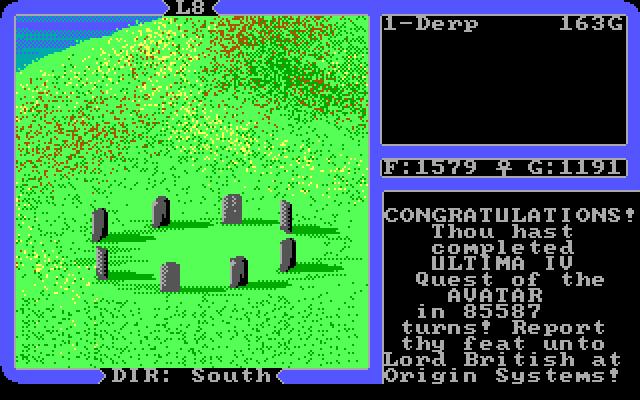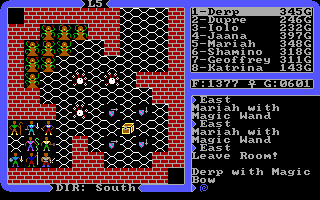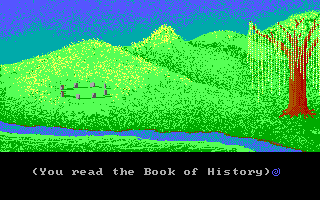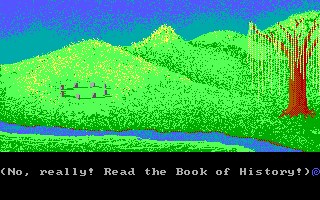During the summer of 1986, I spent a lot of time at the public library in Salem, Oregon. I was between 6th and 7th grade, and I was spending the summer at my mom's. Since my mom and step dad worked all day and had long commutes, I was bored... for hours. The library had two things that drew a young proto-geek: all of the AD&D books and a computer lab.

The computer lab was quite amazing, and it was years ahead of its time. Anyone with a library card could reserve an hour on any of the computers in the lab. There was an Apple IIe, and Apple IIc, an original Apple Macintosh, an IBM PC XT 5160, an IBM PCjr, and some sort of weird "luggable" computer with a tiny amber screen.
I spent a lot of time in that lab. I remember spending hours on using MacPaint creating AD&D character sheets for each kind of character class. When I got tired of "working," I spent a bit of time playing some kind of graphical Rogue clone. I mostly stayed away from the IBM computers because they seemed boring. I did try to play Flight Simulator on the PCjr, but there was no way to turn the sound off, and that almost got me banned from the lab.
Most of my time, however, was spent on the Apple II. This was also the summer that I discovered software piracy. I had a box of Elephant 5¼" floppy discs (an elephant never forgets!) full of l337 warez. I spent hours playing Conan, Hard Hat Mack, Mario Bros, and Bolo (a game sorely in need of a remake). There was one game that stood out above all the rest: Ultima IV.
My parents made sure, from a very young age, that I could read and do arithmetic. I was near the top of my class in both. They did not, however, educate me on logic puzzles or quests. For shame! As a result, I struggled with Ultima. There were so many things to find, so many people to interrogate, and so many dungeons to explore. And you had to behave with virtue (this was also the summer that I discovered Slayer and Metallica). I did not finish that game that summer. In fact, I didn't even come close. I don't think I collected any of the items necessary to finish the game, and I only became four parts Avatar.
In 1987 I lined up at the store to get Ultima Exodus for the NES. My dad and I played that game over, and over, and over. I really enjoyed that game. I really enjoyed the simplifications over the computer version of Ultima IV. Talking to people was so much less tedious! Still, Avatarhood beckoned. By that point, my education in logic puzzles and quests was fully underway. It also helped that by that time I had leared to draw maps of dungeons. I believe that this is a skill much like making wagon wheels. It was really important for a while, but now it's nearly useless.
I didn't get access to a computer again until around the middle of the 8th grade. One of the teachers at my middle school started an after school computer club. Mr Paisley was a math teacher and a Mac geek to the core. He had a Mac SE in his class, and it had a device that went on an overhead projector to project the screen. Even the other math teachers thought that was geeky. As a Mac geek and a teacher, he had all the classic Mac thinking games: Shadowgate, Uninvited, and others. I played a bit of Ultima at computer club, but the Mac games, which we played mostly as a group, were too much of a distraction. I didn't have much computer access after that until my sophomore year of high school.
For whatever reason, when Ultima: Quest of the Avatar came out for the NES in 1990, I didn't play it. My dad and I bought it, and he played it quite a lot. I remember him getting really annoyed whenever I'd drop a spoiler based on my vague recollections. I honestly don't remember why I didn't play that game.
In high school I bought my first computer: an Amiga 500. I never got Ultima for the Amiga. My training continued with Black Crypt, Dungeon Master, and Eye of the Beholder. Most of my time on the Amiga was dedicated to solving the mysteries of sine scrollers, shadebobs, and glenzvectors. That is a tale for another day. I still have EoB, but the others seem to have gone missing over the years.
Years later I converted over to PCs. One day at Fry's Electronics, I came across a pack of CDs of 1,000 games or something. One of the discs contained Ultima I through VI (I think). It was only like $10, so I bought it, and I resumed my quest. College, software projects, this new thing called Linux, and life prevented me from spending significant blocks of time questing. I recall several times restarting because, after a multi-month hiatus, I could not remember where I was or what I was doing. Eventually the quest was abandoned.
Last year while I was traveling in Europe, I bought a copy of Ultima IV for the Sega Master Systemat Game Over? in Amsterdam (a very nice retro game shop!). The seed was planted in the back of my mind to resume the quest. I finally decided to pick it up. Over the summer I found complete, in the box copies of Ultima I and Ultima II for Atari 8-bit at a garage sale. Given the amount these go for on eBay, I've been afraid to put the disks in a system to test.
Instead of playing the SMS version, I downloaded it from GoG and played using DOSbox. After about 30 hours of play, I have finally completed a quest over 30 years in the making. It was very, very irritating. Seriously.

That game was amazing and groundbreaking, but many aspects of its design have been improved in the intervening 30+ years. Four aspects stand out in my mind.
Dialog. The dialog in the game is entirely free form. Each NPC has a set of key words that will trigger a response (tip: only the first four characters are checked, so save yourself some typing). After typing
NAME,JOB,MANT,RUNE,SHRI,STON,QUES,MAGI, ... at 100 people, it gets pretty tedious. Doing your taxes kind of tedious. I feel like games have gone a bit too far the other way in modern times. People just spill their guts as soon as you talk to them. I'm not sure what the middle ground would be.Combat. Once you have all eight characters, combat is just a chore. You can't walk through your own characters, even when they're magically asleep, and many of the rooms have twisty, narrow hallways. Add to that rooms full of monsters that cast sleep spells, and you'll want to punch yourself in the face. Have fun on levels 5, 6, and 8 of the Stygian Abyss.

All nine of those Reapers love to cast sleep on the whole party, and the Gazers can put a single character to sleep. On multiple occasions, my entire party was asleep for over a minute. When one of the lazy bums did wake up, it was usually a guy in the back that could neither attck nor cast the "awake" spell on another character.
Secrets. There are many rooms, especially in the Stygian Abyss, that have secret "trigger plates" in the floors. There is no way to know where these are. You just have to step on every tile and watch for something to change in the room. This includes tiles covered with lava. Have fun navigating all of this with eight characters. If one accidentally exits through the wrong exit, everyone has to go out and try the room again.
Magic. This almost didn't make the list, but one aspect really annoys me. Ultima uses a fairly standard system of magic points. It also uses a system where spells require mixtures made of ingredients that must be bought or found. In many ways this is a feature. Talking to people to learn new spell mixtures was fun. The problem is that you can't mix reagents while in combat or combat rooms of dungeons. This includes rooms that are cleared of enemies and rooms that never had enemies. In the Stygian Abyss, there are several long, connected sequences of rooms. Several rooms require use of the "dispel" spell to pass. If you run out of mixtures, you have to go all the way back. This includes having to pass one of the annoying maze rooms with creatures that put your party to sleep.
I enjoyed the game right up until the Stygian Abyss. The game crossed over from fun to pure frustration. The lower levels are filled with rooms that only allow a single character at a time to advance into a position to attack the enemies, and those rooms are invariably filled with enemies that cast sleep spells in the character in front. Once those rooms are cleared, most have invisible floor triggers that must be activated. That is fine, but many of them cause secret doors to appear. The secret doors are noted by a single pixel dot in the brick pattern of the walls. On a low resolution display of 1985, these were easy to pick out. In a 640x400 window on a 2560x1600 display, they're basically invisible. I don't blame Richard Garriot for that one, but it still made things more frustrating.

If I were to play the game again, and in all honesty I probably will, I would do a few things differently.
RTFM. The intro sequence tells you to read The History of Britania, but I didn't exactly download that from GOG. There are a lot of things that you don't even know you need to do without the book. In the old days, bits were expensive and paper was cheap. Now bits are basically free, and you can't download paper over the Internet.


I would probably play the Sega Master System version. I think that would save some of the dialog tedium. The trade-off is that I think it would make combat even more irritating. On computer versions, combat commands are selected by different keys on the keyboard. On console versions, combat commands are selected using a menu.
The NES version, apparently, removed a bunch of things. The graphics also look a little too goofy for me to take seriously.
If I played again on the computer, I would use the
normal3xscaling mode in DOSbox. Always check the configuration options of your emulator before you get too into things.Wait until as late as possible to pick up the last few characters. Juggling eight characters around in combat is not fun in any dungeon. You can only have as many characters as the level of your main character. This time around I got my main leveled up pretty quickly and picked up all but the last companion. This has two advantages. First, the core group of characters will be higher level during the final dungeon. Second, a lot less time and irritation will be spent juggling a large party in the earlier dungeons.
Geoffery and Katrina are especially useless. Neither can use magic. Geoffery's strongest ranged weapon is the crossbow, and Katrina's is
Now I have to go play Ultima V...